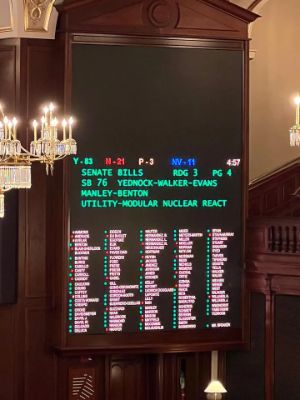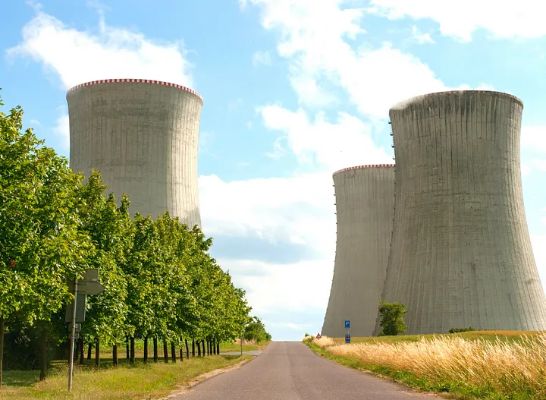Author: Anna Grindeland
Nuclear power has experienced impressive growth and innovative breakthroughs in the past year. Countries are turning to nuclear to reduce emissions, bolster energy security, and provide reliable power to consumers. This progress is also seen in the U.S., where 24 state legislatures introduced over 60 pieces of legislation of spurring nuclear development. These bills include authorizing feasibility studies on advanced nuclear power, lifting decades-long moratoriums, and creating workforce development programs to help launch university research and development efforts.
The public perception of nuclear energy is also changing, especially in the United States. A new Gallup poll found that American support for nuclear power is the highest it’s been in decades. Specifically, the poll found that 55% of U.S. adults either “strongly” or “somewhat” favor the use of nuclear energy.
This positive change in the public perception, plus recent policy wins worldwide, is evidence that the nuclear industry is poised to have a global renaissance. Here are two countries and two states that are already leading the charge.

The United Kingdom: Rising from the Ashes
Though nuclear power’s contribution to the UK’s energy mix has declined from 25% in the late 1990s to 15% in 2022, a resurgence is on the horizon. With half of the UK’s current nuclear capacity set for decommissioning by 2025 and only one new plant under construction, Hinkley Point C, the UK is setting its sights on a net-zero greenhouse gas emissions target by 2050, where nuclear power will fulfill at least 25% of the nation’s electricity needs.
In a game-changing move, the UK recently classified nuclear energy as environmentally sustainable and added it to Britain’s green taxonomy. This bold step ensures nuclear energy receives the same federal investment incentives as other clean energy forms in the country.
Though six plants currently supply about 20% of UK electricity demand, most are nearing the end of their lifespans. The government plans to approve one new reactor annually until 2030, culminating in eight new reactors with the capacity to power 12 million homes.
Rolls-Royce SMR Ltd may revolutionize the industry with its factory-built nuclear power plant, offering clean, affordable energy for all. This approach promises to lower costs and reduce uncertainty and risk for developers, which would empower countries worldwide to address their urgent need for low-carbon energy.
Poland: A New Era of Nuclear Power
Despite holding Europe’s largest coal reserves and relying on coal for 70% of its energy in 2020, Poland is emerging as a nuclear power trailblazer.
In 2005, Poland’s energy cabinet initiated a shift towards nuclear power to curb emissions. The Polish government passed a five-step plan in 2011 to expand nuclear energy deployment, establishing the Nuclear Power Program, which maps out growth strategies for nuclear power through 2040. In 2021, Poland announced regulatory reforms to accelerate nuclear power deployment and pledged to phase out coal use by 2040 to achieve net-zero emissions by 2050.
Overcoming years of financing and licensing delays, Poland signed a contract with Westinghouse Electric in 2026 to construct its first nuclear power plant, featuring the AP1000 nuclear reactor. The plant is projected to supply power to the grid by 2032.
Poland is also exploring small modular reactors as a path to energy security and climate goals. Earlier this year, Polish mining and processing firm KGHM Polska Miedź S.A. signed a memorandum of understanding with NuScale for the deployment of its VOYGR reactor by 2029. And finally, Washington D.C.-based Last Energy has committed to delivering ten 20-megawatt SMRs to the Legnica Special Economic Zone in southwestern Poland.
Illinois: Illuminating a Clean Energy Future
In September 2021, Illinois became the first state in the Midwest to set an aggressive timetable for reaching 100% renewable energy by 2050 or net zero carbon emissions.
Illinois relies on nuclear power for over 50% of its energy supply, with an additional contribution of over 20% from coal. The state is home to eleven operational commercial nuclear power reactors located at six sites. Notably, Illinois stands as the leading state in nuclear power production, responsible for approximately one-eighth of the total nuclear power generated in the nation.
Recently, Illinois voted to pass SB76 which lifts the 30-year moratorium on nuclear power plant construction in the state. As of May 18, the House passed it with a vote of 84–22. New projects could be either traditional nuclear reactors or new small modular reactors (SMRs).

Virginia: The Eastern Vanguard of New Nuclear
In Virginia, the dominant sources of electricity are natural gas and nuclear power, contributing 57% and 30% respectively. To further strengthen the role of nuclear power, the Virginia General Assembly passed a series of bills during its 2023 legislative session. Notably, HB2386 established the Power Innovation Fund and Program, aimed at fostering advancements in nuclear energy. HB1779 enables competitive grants to support educational initiatives related to nuclear energy within Virginia. Furthermore, SB1116 grants authority to the Southwest Virginia Energy Research and Development Authority to drive energy projects on former coal sites and facilitate the development of workforce training programs in the energy sector.
The Power Innovation ‘Fund’ will provide funding solely for the research and development of innovative technologies such as nuclear power, carbon sequestration, and energy storage, while the ‘Program’ awards grants to support higher education research on advanced nuclear technologies, workforce development, and site selection for future SMRs. These dual programs will be especially important as Governor Youngkin looks to deploy the country’s first commercial SMR plant in southwest Virginia.
Virginia is also home to BWXT, headquartered in Lynchburg. The company develops nuclear reactor components for Navy submarines and aircraft carriers. BWXT’s Lynchburg facility houses the world’s first commercial Critical Experiment Laboratory and has been in operation for over 60 years. BWXT’s Uranium Processing and Research Reactors currently supplies U.S. colleges, universities, and national laboratories with research reactor fuel and is the only North American company to do so. The company is also working with the Department of Energy’s Advanced Reactor Demonstration Program to deploy “a modular, factory-fabricated system that is small and light enough to be transported via rail, ship or truck and can deliver 50 MW of thermal nuclear reactor power.”
The examples above do not even scratch the surface of the renewed interest in nuclear worldwide. The sections below provide a quick look into other states and countries springing into nuclear power in the past year.

Nuclear Around the World
The United States
In addition to Virginia and Illinois, 22 other states have introduced or passed legislation that would bolster nuclear power within their respective borders. Here is a quick snapshot of the state of nuclear energy in and around the U.S.:
- Arizona — Arizona recently introduced HB2218 which encourages energy storage projects related to nuclear energy and renewable power.
- Arkansas — Signed HB1142 into law which establishes the Arkansas Fuel Recycling Program. Under this legislation, Arkansas will conduct a feasibility study to measure the commercial viability of recycling spent nuclear fuel in the state and establish a nuclear science and engineering program at the University of Arkansas.
- California — As of this writing, CA has two bills in committee (AB65 and AB1172) that would lift the moratorium on new nuclear power in the state and conduct a feasibility study for nuclear fusion, respectively.
- Colorado — Colorado’s Democrat-controlled state government has been resistant to nuclear energy development in the state, killing HB1080, which would have labeled nuclear power as a clean energy source, and SB79, which granted a feasibility study for advanced nuclear power. The state currently has one bill in committee, HB1247, which would study advanced nuclear’s feasibility for rural areas.
- Connecticut — Three bills have been introduced in the 2023 legislative session, two of which have been filed to be voted on in the Senate (SB1099 and SB1170). These two bills would establish a nuclear advisory council and direct the state’s Department of Energy and Environmental Protection to study the potential need for procurement of zero-carbon electricity generated by nuclear power plants, respectively.
- Florida — Florida’s H1137 would urge the President and Congress to take action to adjust regulatory policy as necessary to allow states to conduct feasibility studies on reclamation and repurposing spent nuclear fuel for new nuclear energy generation.
- Hawaii — Hawaii’s House of Representatives has introduced HB927 which would conduct a nuclear fusion feasibility study. The bill has been in committee since January.
- Illinois — The paramount nuclear-related bill in Illinois is SB76, which lifts the state’s ban on new nuclear power construction. The bill passed the Senate and the House Public Utilities Committee.
- Indiana — The General Assembly passed HB1421 which expands the state utilities’ financial incentives to boost natural gas and nuclear power production.
- Kentucky — Kentucky’s General Assembly passed SJR79, a joint resolution that establishes the Nuclear Energy Development Working Group. This group will identify the barriers to the deployment of nuclear power generation and related technologies and consult with stakeholders to develop recommendations for the role of a permanent nuclear energy commission to be established in the state government.
- Maine — Maine’s Legislature recently introduced LD1549 which directs the Public Utilities Commission to seek informational bids regarding small modular nuclear Reactors in the state.
- Maryland — SB719 recently passed which directs nuclear energy (and other power) generators to coordinate with the Department of Emergency Management to develop an information distribution plan to disseminate energy-related information to the public.
- Minnesota — The state legislature has introduced several nuclear-related bills, one of which directs the commissioner of commerce to conduct a feasibility study on advanced nuclear power, another that allows for the construction of small modular reactors (up to 300 megawatts), and another that provides energy transition grant funding for communities that have been impacted by nuclear power plant closures.
- Nebraska — The state legislature has introduced two bills that pertain to nuclear power, one of which establishes a hydrogen and nuclear energy working group, and another that creates a committee within the legislature called the Small Modular Nuclear Reactor Study Committee.
- New Hampshire — New Hampshire’s HB616 would amend the state’s renewable portfolio standard to include nuclear power generation.
- New Jersey — In February, New Jersey’s senate introduced S3556 which would establish the position of Clean Energy Advocate in the Board of Public Utilities to facilitate coordination and cooperation among various State agencies in association with the implementation of interagency clean energy projects, which include nuclear power.
- New Mexico — The Advanced Energy Technology Act was introduced which establishes grants, funding, and public-private partnerships for advanced energy projects, which includes nuclear power.
- North Dakota — Two resolutions were signed by Governor Burgum. One urges the federal government to recognize natural gas and nuclear energy as environmentally sustainable economic activities and the other directs the Legislative Management to study sustainable energy policies.
- Oklahoma — SB847, which directs the Department of Environmental Quality to conduct a nuclear power feasibility study, passed over to the House on March 8th, 2023.
- Oregon — Two bills were introduced in the Oregon House of Representatives. One establishes a tax credit for energy production in the state, while the other allows counties to approve permits for small modular reactors.
- Texas — Texas’ legislature introduced a feasibility study bill and a bill that would fund the construction of thermal and nuclear power generating facilities.
- Virginia — Virginia passed three bills this session to advance nuclear power in the state. These are HB2386, which created the Power Innovation Fund and Program, HB1779 which awards competitive grants to advance nuclear energy education initiatives in Virginia, and SB1116 which empowers the Southwest Virginia Energy Research and Development Authority to promote energy projects on former coal sites and develop energy workforce training programs.
- West Virginia — The state legislature is taking steps to become an Agreement State and recently passed a joint resolution that directs Marshall University and West Virginia State University to work together with the private sector to develop policies and programs to facilitate nuclear energy developments in the state.
- Washington — SB5129 reaffirms Washington’s commitment to grow its nuclear energy portfolio while HB1123 would support nuclear power siting on Native lands and HB1194 would establish renewable and clean energy workforce development programs.

North America
All but one of the country’s 19 nuclear reactors are sited in Ontario. Ten of those units — six at Bruce and four at Darlington — are to undergo refurbishment.. The program will extend the operating lifetimes by 30–35 years. Similar refurbishment work enabled Ontario to phase out coal in 2014, achieving one of the cleanest electricity mixes in the world.
The second reactor at Mexico’s Laguna Verde nuclear power plant has been granted an extension to its operating license, taking the plant’s life into the mid-2050s. Nuclear is seen doubling its contribution in advance of Mexico’s 2050 targets.
South America
Argentina’s CAREM 25 Small Modular Reactor (SMR) is under construction, and in February 2022, the utility company Nucleoeléctrica Argentina S.A. (NA-SA) and the China National Nuclear Corporation (CNNC) signed a commercial contract for the construction of Atucha III, Argentina’s fourth nuclear power plant, to be installed in the Atucha Nuclear Complex.
Construction of the country’s third nuclear power reactor recommenced in November 2022 in Brazil after being stalled for over seven years.
West and Central Europe
Belgium reached an agreement with French utility Engie in January 2023 to extend the life of two nuclear reactors by 10 years.
Finland’s much-delayed Olkiluoto 3 (OL3) nuclear reactor, Europe’s largest, began regular output earlier this month, its operator said, boosting energy security in a region to which Russia has cut gas and power supplies. OL3’s operator Teollisuuden Voima (TVO), which is owned by Finnish utility Fortum (FORTUM.HE) and a consortium of energy and industrial companies, has said the unit is expected to meet around 14% of Finland’s electricity demand, reducing the need for imports from Sweden and Norway. The new reactor is expected to produce for at least 60 years, TVO said in a statement on Sunday after completing the transition from testing to regular output.
It is one of the most nuclear-powered countries in the world. It has 56 operable nuclear reactors, with a combined net capacity of 61.4 GWe. In 2021, nuclear generated 69.0% of the country’s electricity.
France provides about 15% of Europe’s total power through exports.
A 2015 energy policy aimed to reduce the country’s share of nuclear generation to 50% by 2025. This target has now been postponed to 2035. The country’s energy minister said that the target was not realistic, increasing the country’s carbon dioxide emissions, endangering security of supply, and putting jobs at risk.
One reactor is currently under construction in France — a 1750 MWe EPR at Flamanville.
To meet its energy transition goals, the Netherlands has announced plans to construct two new nuclear power plants by 2035. According to the Dutch government’s statement in December 2022, these anticipated facilities are expected to contribute up to 13% of the country’s electricity production. The power plants need to play an important role in the country’s energy transition, as the Netherlands aims to make its power production carbon-neutral by 2040.
The government energy and climate plan specifies that installed nuclear capacity will remain at current levels of about 7,100 MW until at least 2025 but will be reduced to just over 3,000 MW from 2030 onwards.
Sweden’s six nuclear power reactors provide about 40% of its electricity. In 1980, the government decided to phase out nuclear power, but in June 2010, parliament voted to repeal this policy. The country’s 1997 energy policy allowed ten reactors to operate longer than the 1980 phase-out policy envisaged, resulting in the premature closure of the two-unit Barsebäck plant.
In 2015, decisions were made to close four older reactors by 2020. Ringhals 1 and 2 were closed at the end of 2020 and 2019, respectively — several years earlier than planned due to the economic impact of punitive taxes. When it announced its intention to close the plants in October 2015, Vattenfall said: “Market conditions and the impact of the high output tax have prompted us to limit investments in Ringhals 1 and 2.”
In June this year, Vattenfall announced it was initiating a pilot study to assess the conditions for proceeding with a decision to build at least two SMRs adjacent to the Ringhals plant. The study is expected to be completed by around late-2023 or early-2024.
The UK has 15 operational nuclear reactors, comprising just less than 20% of the United Kingdom’s electricity. Fourteen operating reactors are scheduled to be shut down by 2030, but the United Kingdom plans to bring new plants online by 2025 to offset some of the expected loss in nuclear generation.
The UK has also recently classified nuclear energy as environmentally sustainable, as Chancellor Jeremy Hunt added nuclear to Britain’s green taxonomy. Green taxonomies channel investment toward sustainable economic activities and assets, meaning nuclear energy will now access the same federal investment incentives as other forms of clean energy in Britain.
Rolls-Royce has been working on a Micro-Reactor program “to develop technology that will provide the power needed for humans to live and work on the Moon.” The UK will now provide £2.9 million (around $3.52 million) of funding for the project.
Central and East Europe, Russia
Belarus’ first nuclear power plant’s unit 2 reached the minimum controllable power level last month with a self-sustaining controlled nuclear reaction.
Energy Minister Rossen Hristov has set out an energy strategy for 2023 to 2053 for Bulgaria, which includes plans for two new reactors at Kozloduy and two at Belene.
Prime Minister Nicolae Ciucă announced in November 2022 that two new nuclear reactors would be built at the Cernavoda atomic power plant in the country’s southeast after Romania contracted two loans from the US.
Russia has 37 operable nuclear reactors, with a combined net capacity of 27.7 GWe. In 2021, nuclear generated 20.0% of the country’s electricity.
A government decree 2016 specified the construction of 11 nuclear power reactors by 2030 in addition to those already under construction. At the start of 2022, Russia had three reactors under construction, with a combined capacity of 2.6 GWe.
The strength of Russia’s nuclear industry is reflected in its dominance of export markets for new reactors. The country’s national nuclear industry is currently involved in new reactor projects in Belarus, China, Hungary, India, Iran, and Turkey, and to varying degrees as an investor in Algeria, Bangladesh, Bolivia, Indonesia, Jordan, Kazakhstan, Nigeria, South Africa, Tajikistan, and Uzbekistan among others.
Through state-owned nuclear power company Rosatom, Russia dominates the global nuclear supply chain. It was Europe’s third-largest supplier of uranium in 2021, accounting for 20 percent of the total.
In May 2023, Turkey’s first nuclear reactor will receive its first fresh fuel. The Akkuyu nuclear power plant — which includes four units of Russian-designed VVER-1200 reactors — is expected to be fully operational by 2026.
Asia
Bangladesh started construction on the first two planned Russian VVER-1200 reactors in 2017. Construction on the second started in 2018. It plans to have the first unit in operation by 2023.
As of April 2023, Bangladesh is constructing the first of two nuclear power plants in conjunction with Russia.
China has 55 operable nuclear reactors (38 nuclear power reactors in operation and 19 under construction). China is the fastest-expanding nuclear power generator in the world. In 2021, nuclear generated 5.0% of the country’s electricity.
It has six nuclear power units in operation, four under construction, and several reserved sites for future projects.
The Indian government is committed to growing its nuclear power capacity as part of its massive infrastructure development program. In 2010, the government set an ambitious target to have 14.6 GWe nuclear capacity online by 2024. At the end of July 2022, eight reactors were under construction in India, with a combined capacity of 6.7 GWe.
India’s government is pushing to construct more nuclear power plants as the country looks to increase its supply of cleaner energy. Officials have called for as many as 20 new nuclear power facilities to be brought online over the next decade, more than doubling the number of operating nuclear power plants in the country.
Japan has 33 operable nuclear reactors, with a combined net capacity of 31.7 GWe. As of March 2022, 10 reactors had been brought back online, with a further 15 in the process of restart approval, following the Fukushima accident in 2011. In the past, 30% of the country’s electricity has come from nuclear; in 2021, the figure was just 7.2%.
Japan adopted a plan in December 2022 to extend the lifespan of nuclear reactors, replace the old and even build new ones. Under the new policy, Japan will maximize the use of existing reactors by restarting as many of them as possible and prolonging the operating life of aging ones beyond a 60-year limit. The government also pledged to develop next-generation reactors. The Japanese government has recommitted to the technology, including setting a target for nuclear power to make up 20–22% of the country’s energy mix by the decade’s end.
South Korea has three new reactors under construction domestically and is constructing a four-unit plant in the United Arab Emirates. Nuclear energy will account for 34.6% of South Korea’s electricity generation by 2036, compared with 27.4% in 2021.
Pakistan has one Chinese Hualong One unit under construction, which achieved its first criticality in February 2022. Pakistan currently operates six nuclear power reactors at two sites, generating about 10 percent of the country’s total and almost a quarter of its low-carbon electricity.
Africa
Egypt started construction in July 2022 of the first of four Russian-designed VVER units to be built at the El Dabaa site on the Mediterranean coast. The second unit began construction in November 2022. All four reactors are expected to be operational by 2030. Egypt’s goal is for nuclear power to represent 9% of electricity by 2030, which would be achieved by the commercial operation of the first two units by that time.
Middle East
In December 2022, Iran announced the construction of a new nuclear power plant. The new 300-megawatt plant, known as Karoon, will take eight years to build and cost around $2 billion, the plant will be located in Iran’s oil-rich Khuzestan province, near its western border with Iraq, it said.
The UAE has three operable nuclear reactors with a capacity of 4.0 GWe. A fourth unit is under construction at the same plant (Barakah). In 2021, nuclear generated 1.3% of the country’s electricity. In February of 2023, the third unit at the UAE’s nuclear power plant was declared in commercial operation.
Conclusion
The resurgence of nuclear power on both the global and national stages is good news as the world looks to address climate change in an economically feasible way. As innovation continues and public perception shifts, expect nuclear power to play a growing role in future energy strategies.


